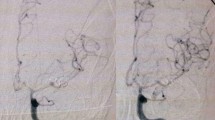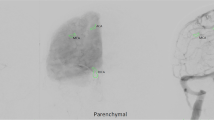Abstract
Objective: We examined the effect of intraarterial administration of fasudil hydrochloride (IAFC), a Rho kinase inhibitor, for the prevention of symptomatic vasospasm after SAH by evaluating cerebral circulation.
Methods: We evaluated IAFC cases of 57 sides of 38 patients (12 men and 26 women, average age 60.2 years old) diagnosed with aneurysmal subarachnoid hemorrhage (SAH) from February 2012 to November 2012. All cases were treated by clipping or coil embolization within 48 h after onset. Indication for IAFC was the existence of a spastic change on follow-up digital subtraction angiography (DSA) compared with that of onset.
Results: Clipping was performed in 30 cases and coil embolization in 8 cases. IAFC was performed an average of 6.6 days after onset. Color gradient mapping demonstrated reduction of the circulation time after IAFC compared with before IAFC on 39 sides, no change on 15 sides, and extension on 3 sides. Average arterial circulation time before IAFC was 2.25 ± 0.57 s and after IAFC was 1.95 ± 0.55 s. IAFC significantly shortened average arterial circulation (P = 0.005). No case developed symptomatic vasospasm after IAFC.
Conclusion: IAFC significantly reduced the cerebral circulation time after aneurysmal SAH and might be effective for the prevention of symptomatic vasospasm.
Access this chapter
Tax calculation will be finalised at checkout
Purchases are for personal use only
Similar content being viewed by others
References
Ingall T, Asplund K, Mahonen M, Bonita R (2000) A multinational comparison of subarachnoid hemorrhage epidemiology in the WHO MONICA stroke study. Stroke 31:1054–1061
Inoue M, Sasaki T, Takazawa H, Morita T, Narisawa A, Saito A, Midorikawa H, Nishijima M (2013) Symptomatic vasospasm in elderly patients with aneurysmal subarachnoid hemorrhage: comparison with nonelderly patients. Acta Neurochir Suppl 115:281–284
Iseda T, Nakano S, Yoneyama T, Ikeda T, Moriyama T, Sameshima T, Goya T, Wakisaka S (2000) Angiographic cerebral circulation time before and after endovascular therapy for symptomatic vasospasm. Clin Radiol 55:679–683
Ito H, Inugami A, Shishido F, Okudera T, Ogawa T, Hatazawa J, Fujita H, Shimosegawa E, Kanno I, Fukuda H (1994) Circulation time determined by carotid angiography in patients with chronic internal carotid artery occlusion: Comparison with cerebral blood flow and oxygen metabolism measured by PET [in Japanese]. Kaku Igaku 31:1193–1199
Kim I, Leinweber BD, Morgalla M, Butler WE, Seto M, Sasaki Y, Peterson JW, Morgan KG (2000) Thin and thick filament regulation of contractility in experimental cerebral vasospasm. Neurosurgery 46:440–446
Ohkuma H, Manabe H, Tanaka M, Suzuki S (2000) Impact of cerebral microcirculatory changes on cerebral blood flow during cerebral vasospasm after aneurysmal subarachnoid hemorrhage. Stroke 31:1621–1627
Okawara SH, Kimura J, Hahn JY (1974) Cerebral circulation time with ruptured intracranial aneurysms. J Neurosurg 41:415–420
Pradilla G, Thai QA, Legnani FG, Hsu W, Kretzer RM, Wang PP, Tamargo RJ (2004) Delayed intracranial delivery of a nitric oxide donor from a controlled-release polymer prevents experimental cerebral vasospasm in rabbits. Neurosurgery 55:1393–1400
Sasaki T, Kodama N, Kawakami M, Sato M, Asari J, Sakurai Y, Watanabe K, Onuma T, Matsuda T (2000) Urokinase cisternal irrigation therapy for prevention of symptomatic vasospasm after aneurysmal subarachnoid hemorrhage: a study of urokinase concentration and the fibrinolytic system. Stroke 31:1256–1262
Sato M, Tani E, Fujikawa H, Kaibuchi K (2000) Involvement of Rhokinase-mediated phosphorylation of myosin light chain in enhancement of cerebral vasospasm. Circ Res 87:195–200
Satoh S, Yamaguchi T, Hitomi A, Sato N, Shiraiwa K, Ikegaki I, Asano T, Shimokawa H (2002) Fasudil attenuates interstitial fibrosis in rat kidneys with unilateral ureteral obstruction. Eur J Pharmacol 455:169–174
Satoh S, Hitomi A, Ikegaki I, Kawasaki K, Nakazono O, Iwasaki M, Mohri M, Asano T (2010) Amelioration of endothelial damage/dysfunction is a possible mechanism for the neuroprotective effects of Rho-kinase inhibitors against ischemic brain damage. Brain Res Bull 81:191–195
Shibuya M, Suzuki Y, Sugita K, Saito I, Sasaki T, Takakura K, Nagata I, Kikuchi H, Takemae T, Hidaka H (1992) Effect of AT877 on cerebral vasospasm after aneurismal subarachnoid hemorrhage. J Neurosurg 76:571–577
Shibuya M, Hirai S, Seto M, Satoh S, Ohtomo E (2005) Effects of fasudil in acute ischemic stroke: results of a prospective placebo-controlled double-blind trial. J Neurol Sci 238:31–39
Siasios I, Kapsalaki EZ, Fountas KN (2013) Cerebral vasospasm pharmacological treatment: an update. Neurol Res Int. doi:10.1155/2013/571328
Suzuki Y, Shibuya M, Satoh S, Sugimoto Y, Takakura K (2007) A postmarketing surveillance study of fasudil treatment after aneurismal subarachnoid hemorrhage. Surg Neurol 68:126–132
Suzuki Y, Shibuya M, Satoh S, Sugiyama H, Seto M, Takakura K (2008) Safety and efficacy of fasudil monotherapy and fasudil-ozagrel combination therapy in patients with subarachnoid hemorrhage: sub-analysis of the post-marketing surveillance study. Neurol Med Chir 48:241–248
Udoetuk JD, Stiefel MF, Hurst RW, Weigele JB, LeRoux P (2007) Admission angiographic cerebral circulation time may predict subsequent angiographic vasospasm after aneurismal subarachnoid hemorrhage. Neurosurgery 61:1152–1161
Yamamoto S, Watanabe M, Uematsu T, Takasawa K, Nukata M, Kinoshita N (2004) Correlation of angiographic circulation time and cerebrovascular reserve by acetazolamide-challenged single photon emission CT. AJNR Am J Neuroradiol 25:242–247
Conflict of Interest Statement
We declare that we have no conflict of interest.
Author information
Authors and Affiliations
Corresponding author
Editor information
Editors and Affiliations
Rights and permissions
Copyright information
© 2015 Springer International Publishing Switzerland
About this chapter
Cite this chapter
Saito, A. et al. (2015). Effectiveness of Intraarterial Administration of Fasudil Hydrochloride for Preventing Symptomatic Vasospasm After Subarachnoid Hemorrhage. In: Fandino, J., Marbacher, S., Fathi, AR., Muroi, C., Keller, E. (eds) Neurovascular Events After Subarachnoid Hemorrhage. Acta Neurochirurgica Supplement, vol 120. Springer, Cham. https://doi.org/10.1007/978-3-319-04981-6_50
Download citation
DOI: https://doi.org/10.1007/978-3-319-04981-6_50
Published:
Publisher Name: Springer, Cham
Print ISBN: 978-3-319-04980-9
Online ISBN: 978-3-319-04981-6
eBook Packages: MedicineMedicine (R0)




